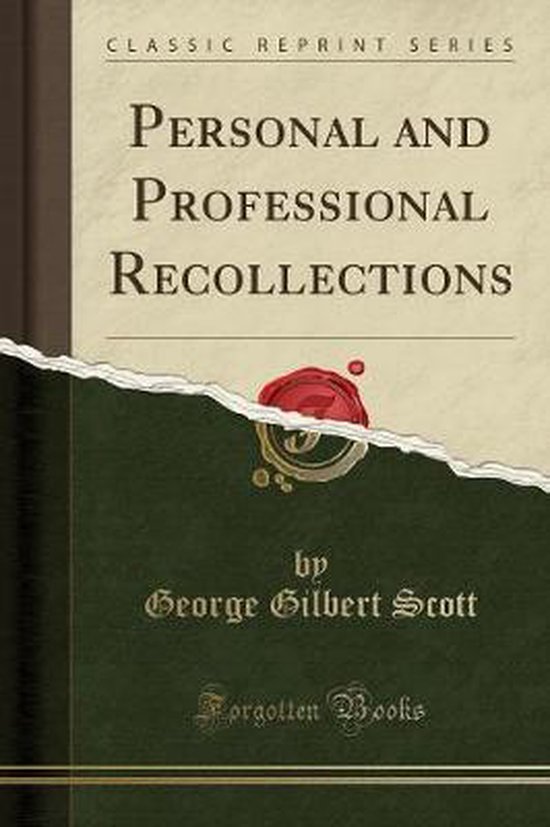George Gilbert Scott
Original: 1879 Sampson, Low, Marston, Searle & Rivington.
This edition: 2018 Forgotten Books.

Sir George Gilbert Scott (1811 – 1879) was the leading architect in the Gothic style. His book is part diary on his life and struggles, and part summary of his work designing or restoring churches, cathedrals and public buildings.
With any changes or renovations that he did to a church he strived to restore the original design, and reverse botched modern changes. When working on St Asaph Cathedral he made the mistake of bowing to pressure from the client to press on without enough historical research to guide the design:
“The chancel…had been externally renewed in…horrid architecture, early, I suppose, in this century; not the smallest trace of its old design being left. There were extant early prints of it, and from these I made a design for its restoration, but accompanied it by earnest advice, not to act upon it until the whole work had been stripped of modern concealment, and evidences of its original design searched after. This the Dean and Chapter ignored…and I, in an evil moment of weakness, yielded. I introduced two couplets on either side, designed as closely as I could from the prints; when at length, as the work approached the central tower, to our dismay the old details made their appearance…I could not well ask for money to re-do all I had done, and yet I could not repeat it in the face of facts such as these. I therefore restored the remaining windows on either side correctly, and left the others to take their chance: monuments of weak compliance, and beacons to warn others against such foolish conduct. There ought to be a brass plate set up recording our shame and our repentance.” (Page 319)
He had other problems with clients. His Gothic design to build the Foreign and Commonwealth Office building won the architectural competition and he was granted the contract. However, Lord Palmerston didn’t like Gothic architecture and tried to make Scott resign in a huff by instructing a rival architect to undermine him:
“a friend called, and told me he was sure that something secret was being transacted with one of the original competitors, for when, in casual conversation with this gentleman, he had referred to the Foreign Office, so extra-ordinary an expression had come over his countenance that he was convinced that some mischief was brewing. Some time later another friend told me that he had discovered that a design for the Foreign Office was being prepared by this architect!…I now saw how matters stood. Lord Palmerston had…secretly encouraged him to make a design, that he might have “two strings to his bow.” (Page 193)
Scott stood his ground and refused to yield to someone else’s design. Palmerston then required Scott to produce a Classical, non-Gothic design, which Scott reluctantly did. Palmerston didn’t like that design either and again tried to get Scott to resign by snubbing him:
“Palmerston allowed several weeks to elapse…before he made an appointment with me to see [the new design]. When he did so, he kept me waiting for two hours and a half in his back room (during a part of which I heard him very deliberately going through his luncheon in the next room), and then sent me away unseen.” (Page 194).
Scott persevered and his alternative design was eventually built, though he was sad about the missed opportunity that his original Gothic design was never built.
In his personal life, like many people today looking back on their life, he regretted working such long hours that he had not spent enough time with his family. Following the death of his wife, he reflected:
“My profession, and its overbearing and perplexing demands on my time and on my thoughts, although it provided her with the means of living in great comfort, was also a cause of much loss of happiness. I was always working under high pressure, ever in a hurry, too often therefore out of humour, and in the evenings jaded, tired and oppressed… I wish I could look back upon having done my utmost to introduce amusements and recreations to compensate for this, but alas! I did not. My life past is made up of subjects for regret. All I can say is, that I worked hard, and endeavoured to provide for her and for my children what they needed for their material well-being.” (Page 260).
An appendix written by his son (also named George Gilbert Scott) records the evening of his death:
“Of the last few days of my father’s life, a very minute account has been preserved by John Pavings, who had long acted as his valet, and for whom, from his constant and faithful service, my father had a high regard.
…a letter arrived from one whom my father had often assisted, a Roman Catholic architect who had had great misfortunes and was lying ill. Pavings was disposed to blame the man, but Sir Gilbert said, “It is very wicked to speak harshly of poor people,” and wrote out a cheque at once. This was the last time my father put pen to paper…He talked cheerfully until about eleven p.m., when his man handed him his Bible and hymn-book…A little before he died he opened his eyes, and lifted them upwards as though in prayer.” (Pages 378 – 381).
Some of the book was heavy going, dull in places or a struggle with technical terms such as “First Pointed” and “Middle Pointed” with no illustrations to help. (A more user-friendly book that explains the technical terms and is packed with photographs is James Stevens Curl, “English Victorian Churches” John Hudson Publishing, 2022).
August 2023
Adrian Vincent